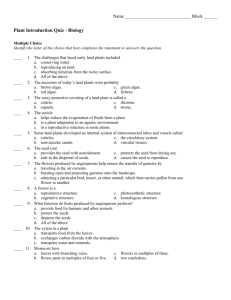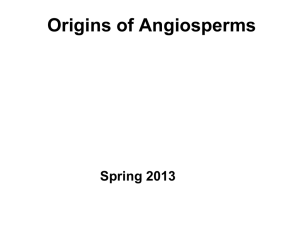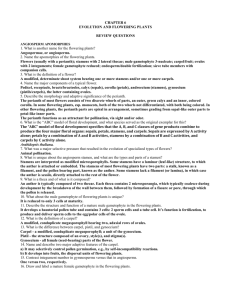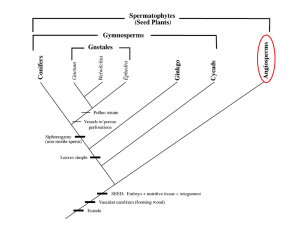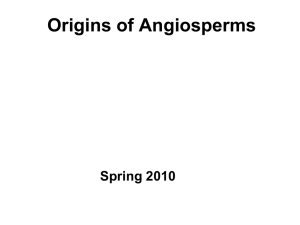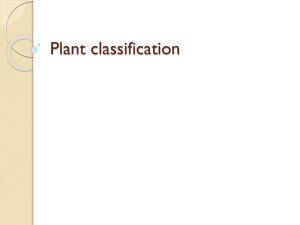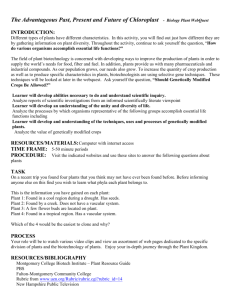A Good Paper
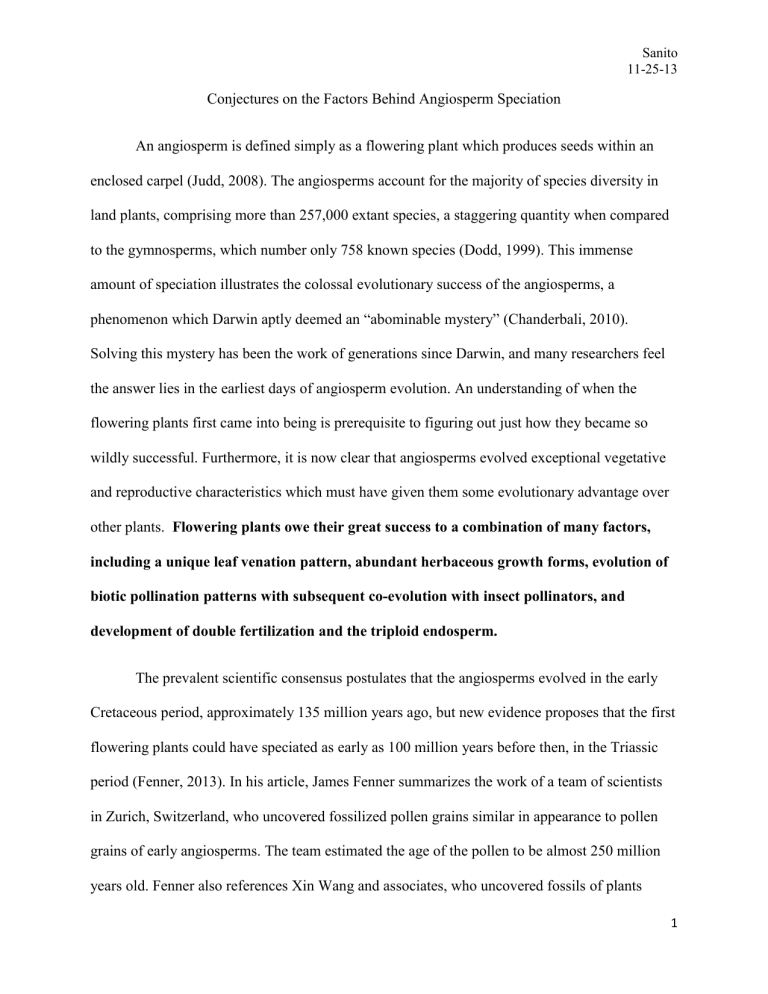
Conjectures on the Factors Behind Angiosperm Speciation
Sanito
11-25-13
An angiosperm is defined simply as a flowering plant which produces seeds within an enclosed carpel (Judd, 2008). The angiosperms account for the majority of species diversity in land plants, comprising more than 257,000 extant species, a staggering quantity when compared to the gymnosperms, which number only 758 known species (Dodd, 1999). This immense amount of speciation illustrates the colossal evolutionary success of the angiosperms, a phenomenon which Darwin aptly deemed an “abominable mystery” (Chanderbali, 2010).
Solving this mystery has been the work of generations since Darwin, and many researchers feel the answer lies in the earliest days of angiosperm evolution. An understanding of when the flowering plants first came into being is prerequisite to figuring out just how they became so wildly successful. Furthermore, it is now clear that angiosperms evolved exceptional vegetative and reproductive characteristics which must have given them some evolutionary advantage over other plants. Flowering plants owe their great success to a combination of many factors, including a unique leaf venation pattern, abundant herbaceous growth forms, evolution of biotic pollination patterns with subsequent co-evolution with insect pollinators, and development of double fertilization and the triploid endosperm.
The prevalent scientific consensus postulates that the angiosperms evolved in the early
Cretaceous period, approximately 135 million years ago, but new evidence proposes that the first flowering plants could have speciated as early as 100 million years before then, in the Triassic period (Fenner, 2013). In his article, James Fenner summarizes the work of a team of scientists in Zurich, Switzerland, who uncovered fossilized pollen grains similar in appearance to pollen grains of early angiosperms. The team estimated the age of the pollen to be almost 250 million years old. Fenner also references Xin Wang and associates, who uncovered fossils of plants
1
Sanito
11-25-13 dating back to the Jurassic period, which they deemed to have qualities similar to those of early angiosperms (Fenner, 2013). Though this is recent evidence, there is older research, too, which supports a similar conclusion. In a 2001 article in Proceedings: Biological Sciences , Wikstrom and colleagues hypothesized that eudicots could have evolved even earlier than the Late Jurassic
(Wikström, 2001).
This information is highly pertinent to understanding how angiosperms expanded so successfully. It has long been held that the Cretaceous period saw an explosion of angiosperm diversification and that this was due to some environmental factor or factors in addition to the angiosperms’ selective advantages. This rapid expansion in angiosperm species diversity saw an accompanying waning in gymnosperm diversity and extinction of many gymnosperm species (Watkins, 2013). If the flowering plants truly are as much as 100 million years older than previously thought, we have come much closer to a possible explanation for their success.
The next step is to look at the timeframe that has been determined for angiosperm proliferation and try to discern what could have tipped the scales against the gymnosperms in favor of the angiosperms. Fossil evidence is insufficient to determine this, but conjectures are being made. Take, for example, one hypothesis which holds that the earliest flowering plants existed in dim and shady habitats (Feild, 2004). Could more suitable light conditions have paved the way for the angiosperms? Consider as well recent evidence which indicates a shift of the ferns and their allies toward epiphytic growth forms during the Cretaceous rise of the angiosperms. This evolutionary shift could have favored both the ferns and the angiosperms, as it reduced competition (Watkins, 2013). Finally, take the convergent evolutions of C
4
and CAM plants, which are thought to be the selective result of a low-CO
2
environment (Edwards, 2012).
Though these specific evolutions probably occurred much later than the Cretaceous, they are
2
Sanito
11-25-13 only examples of plants evolving in response to different selective pressures. The evolutions of these types of plants (as well as of C
3
and CAM-like plants, which are possibly evolutionary intermediates) represent just a few the many speciation events of the angiosperms.
Though they have not yet determined what, if any, environmental influences facilitated the Cretaceous proliferation of the angiosperms, scientists are gradually approaching an understanding as to which of the angiospermous traits are most directly responsible for the expansion and diversification of the clade. Another article from Scientific Proceedings posits that the unique leaf venation of the angiosperms gave them a competitive edge over other clades. In this 2009 article, Kevin Boyce and others demonstrate that angiosperm leaves average about 4 times more leaf venation per mm
2
of leaf surface area than non-angiosperms. As a result, the leaves of flowering plants undergo increased rates of photosynthesis, but also increased rates of transpiration (Boyce, 2009). If this increased rate of photosynthesis really did give the flowering plants an advantage over non-flowering plants with less leaf venation, then this hypothesis could be a part of the answer to the enigma of the resplendent diversity of the angiosperms.
Furthermore if this leaf venation pattern, which is unique to the angiosperms, results in an increased rate of transpiration, this could serve as a partial explanation for the origin of CAM plants, which close their stomata at night to prevent transpiration.
Apart from high density of leaf venation, many angiosperms exhibit herbaceous growth forms. Herbaceous growth is putatively correlated with shorter-lived populations, which could potentially increase the rate of speciation (Dodd, 1999). Dodd and colleagues concluded, based on a review of a number of studies, that the factors most directly responsible for the diversification of angiosperms were most likely to be evolutionary changes in growth form and pollination pattern. In their work on early angiosperms of the Iberian Peninsula, E.M. Friis, et al,
3
Sanito
11-25-13 concluded that Cretaceous angiosperms in that area would have been mostly herbaceous and shrubby, occupying the understory (Friis, 2009). Moreover, in their article “ Within-genus size distributions in angiosperms: Small is better,” Dombroski and Aarssen emphasize that small size classes of angiosperms almost always represent the greatest number of resident species
(Dombroskie, 2010). These facts could together be taken as evidence that early herbaceous angiosperms (so called “paleo-herbs”) speciated rapidly due in part to their growth form and small size. When looking at the large quantity of species in a modern herbaceous flowering family of small size plants such as Asteraceae , one can see why this hypothesis seems a persuasive explanation.
While vegetative characteristics such as leaf venation pattern and herbaceous growth form may have played a part in the angiosperm success story, the unique reproductive physiognomies of the clade are probably even more directly responsible. While non-flowering plants are generally wind-pollinated, most angiosperms have evolved floral parts conducive to attracting animal pollinators, usually one or more species of insect. This adaptive phenomenon between flowering plants and their relative insect pollinators is the best known example of what is often called “co-evolution,” and it has traditionally been viewed as the most likely factor behind angiosperm diversity, but the extent to which insect pollinators drive selection is still unknown (van der Niet, 2012). What complicates the matter is the fact that plant-insect interactions are not always strictly for pollination purposes. Some insects feed on plant matter, and some use the plant for laying eggs. Fossilized insect egg sacs found on fossil leaves demonstrate how ambiguous the concept of co-evolution can be, and they make one cautious to propose any direct correlations (Krassilov, 2007). However, what we do know are the documented associations between pollinator shifts and floral shifts. Many angiosperm orders
4
Sanito
11-25-13 contain one or more clades characterized by a pollinator shift (van der Niet, 2012). Additionally, often a single species of flowering plant is pollinated by a single species of insect. This too implies co-evolution between the angiosperms and their respective pollinators, and when one looks at a flower such as the Bee Orchid, co-evolution seems a rational conclusion.
Unique to flowering plants is the triploid endosperm, which nourishes the embryo inside a seed until the embryo reaches the early stages of maturity. This triploid endosperm is the result of double fertilization, in which one sperm fertilizes an egg and another sperm fuses with two fused female nuclei, a reproductive phenomenon also found solely in the angiosperms
(Friedman, 1995). However, definitive evidence of anything resembling double fertilization in early flowering plants has not yet been found. In an issue of New Phytologist V. Raghavan cautions the reader about making assumptions of double fertilization or triploid endosperm when looking at fossilized ancestors of modern angiosperms, but also notes the four-celled embryo sac of Nymphaeaceae , which is thought by some to be one of the earliest flowering plants. This embryo sac contains an egg cell, two synergids, and a central cell (Raghavan, 2003). It is unknown when double fertilization first appeared in the biological record, and therefore it is impossible to postulate as to what advantage, if any, this trait could have given early angiosperms. What we do know it that formation of the triploid endosperm is a complex and highly adaptive feature, and it seems to be highly advantageous in most environments. Many feel that this reproductive idiosyncrasy could be a contributing factor in the success of the flowering plants.
The traits which most likely were the most directly responsible for the plentiful radiation of the angiosperms include a unique leaf venation pattern, abundant herbaceous growth forms, evolution of biotic pollination patterns with subsequent co-evolution with
5
Sanito
11-25-13 insect pollinators, and development of double fertilization and the triploid endosperm.
Angiosperms comprise the bulk of plant diversity on our planet, outnumbering the gymnosperms in number of species by over 300 to 1. The flowering plants are also humankind’s most important food source. Already, 842 million people in the world do not have enough to eat, and that number is expected to rise. Now, in our age of industrial farming techniques, it is more important than ever to understand just how and when the angiosperms first differentiated, so that we may preserve their remarkable diversity and perhaps eventually tap even further into their potential.
6
Sanito
11-25-13
Works Cited
Boyce, K. (2009). Angiosperm Leaf Vein Evolution Was Physiologically and Environmentally
Transformative. Proceedings: Biological Sciences, 1771-1776.
Chanderbali, A. S. (2010). Conservation and canalization of gene expression during angiosperm diversification. Proceedings of the National Academy of Sciences of the United States of America,
22570-22575.
Dodd, M. (1999). Phylogenetic Analysis of Trait Evolution and Species Diversity Variation among
Angiosperm. Evolution, 732-744.
Dombroskie, S. L. (2010). Within-genus size distributions in angiosperms: Small is better. Perspectives in
Plant Ecology, Evolution and Systematics, 283–293.
Edwards, E. J. (2012). Angiosperm Responses to a Low-CO2 World: CAM and C4 Photosynthesis as
Parallel. International Journal of Plant Sciences, 724-733.
Feild, T. S. (2004). Dark and Disturbed: A New Image of Early Angiosperm Ecology. Paleobiology, 82-107.
Fenner, J. (2013, October 3). Guardian. Retrieved from Guardian.
Friedman, W. E. (1995). Organismal duplication, inclusive fitness theory, and altruism: Understanding the evolution of endosperm and the angiosperm reproductive syndrome. Proceedings of the
National Academy of Sciences, 3913-3917.
Friis, E. M. (2009). Cretaceous diversification of angiosperms in the western part of the. Review of
Palaeobotany and Palynology, 341–361.
Judd, W. S. (2008). Plant Systematics: A Phylogenetic Approach. Sunderland, MA: Sinauer Associates.
Krassilov, V. (2007). Insect egg sets on angiosperm leaves from the Lower Cretaceous of Negev, Israel.
Cretaceous Research, 803-811.
Raghavan, V. (2003). Some Reflections on Double Fertilization, from Its Discovery to the Present. New
Phytologist, 565-583. van der Niet, T. (2012). Phylogenetic evidence for pollinator-driven diversification of angiosperms.
Trends in Ecology & Evolution.
Watkins, J. J. (2013). Ferns in an Angiosperm World: Cretaceous Radiation into the Epiphytic Niche and.
International Journal of Plant Sciences, 695-710.
Wikström, N. (2001). Evolution of the Angiosperms: Calibrating the Family Tree. Proceedings: Biological
Sciences, 2211-2220.
7
Sanito
11-25-13
8

